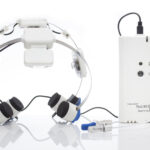Photobiomodulation Parkinson’s Study Results Released
Finally! I have been eagerly waiting to learn results of a 3 year Australian photobiomodulation Parkinson’s study that examined the impact of light therapy (using Vielight.com devices) on symptoms of persons diagnosed with Parkinson’s. Results have finally been published.
examined the impact of light therapy (using Vielight.com devices) on symptoms of persons diagnosed with Parkinson’s. Results have finally been published.
Documented reductions in symptoms far exceeded my expectations. Measures of mobility, cognition, dynamic balance and fine motor skill for the 12 Parkinson’s research subjects were significantly improved (p < 0.05) with photobiomodulation treatment for 12 weeks and up to one year. Many individual improvements were above the minimal clinically important difference, the threshold judged to be meaningful for participants. Individual improvements varied but many continued for up to one year with sustained home treatment.
The design of this study was eloquent. Participants were assessed for mobility, fine motor skills, balance and cognition before treatment began, after 4 weeks of treatment, after 12 weeks of treatment and the end of the home treatment period.
Researchers drew the following conclusions:
“PBM (photobiomodulation) was shown to be a safe and potentially effective treatment for a range of clinical signs and symptoms of PD. Improvements were maintained for as long as treatment continued, for up to one year in a neurodegenerative disease where decline is typically expected.”Â
Contact the company: https://www.vielight.com for information about their photobiomodulation devices and recommendations. The company has offered a 10% discount to members of my audience. Enter the coupon code healing4me on the shopping card or tell them when you call (877-355-8012) that you are with Parkinsons Recovery. The 10% discount will automatically be applied. The company is located in Toronto Canada.
I continue to hear positive reports from members of my audience about the beneficial effects of photobiomodulation therapy. I have identified dozens of natural therapies that offer symptom relief, but would have to put this particular therapy as one of the natural options that promises to offer the most benefit for most (but not all) persons. Consider this option to be worth serious consideration.
Robert
PS: I give myself photobiomodulation therapy every other day using the X-Plus Vielight device. The downside is that it does require a 20 minute commitment for each treatment. Speaking only for myself, I cannot do anything other than do the treatment. The upside is that my mental function has increased substantially: I can remember details now and retrieve mountains of information from long term memory. This really is an amazing therapy!
What follows is an abstract of the study:
BMC Neurol. 2021 Jul 2;21(1):256
Improvements in clinical signs of Parkinson’s disease using photobiomodulation: a prospective proof-of-concept study.
Ann Liebert, Brian Bicknell, E-Liisa Laakso, Gillian Heller, Parastoo Jalilitabaei, Sharon Tilley, John Mitrofanis, Hosen KiatÂ
Abstract
Background: Parkinson’s disease (PD) is a progressive neurodegenerative disease with no cure and few treatment options. Its incidence is increasing due to aging populations, longer disease duration and potentially as a COVID-19 sequela. Photobiomodulation (PBM) has been successfully used in animal models to reduce the signs of PD and to protect dopaminergic neurons.
Objective: To assess the effectiveness of PBM to mitigate clinical signs of PD in a prospective proof-of-concept study, using a combination of transcranial and remote treatment, in order to inform on best practice for a larger randomized placebo-controlled trial (RCT).
Methods: Twelve participants with idiopathic PD were recruited. Six were randomly chosen to begin 12 weeks of transcranial, intranasal, neck and abdominal PBM. The remaining 6 were waitlisted for 14 weeks before commencing the same treatment. After the 12-week treatment period, all participants were supplied with PBM devices to continue home treatment. Participants were assessed for mobility, fine motor skills, balance and cognition before treatment began, after 4 weeks of treatment, after 12 weeks of treatment and the end of the home treatment period. A Wilcoxon Signed Ranks test was used to assess treatment effectiveness at a significance level of 5%.
Results: Measures of mobility, cognition, dynamic balance and fine motor skill were significantly improved (p < 0.05) with PBM treatment for 12 weeks and up to one year. Many individual improvements were above the minimal clinically important difference, the threshold judged to be meaningful for participants. Individual improvements varied but many continued for up to one year with sustained home treatment. There was a demonstrable Hawthorne Effect that was below the treatment effect. No side effects of the treatment were observed.
Conclusions: PBM was shown to be a safe and potentially effective treatment for a range of clinical signs and symptoms of PD. Improvements were maintained for as long as treatment continued, for up to one year in a neurodegenerative disease where decline is typically expected. Home treatment of PD by the person themselves or with the help of a carer might be an effective therapy option. The results of this study indicate that a large RCT is warranted.
